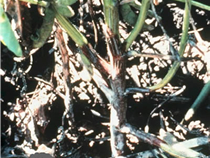Recent Rains Favor Early Season Soybean Diseases
May 6, 2015
With soybean planting just starting in most of the state, recent rains and wet conditions will favor stand and emergence problems. Watch fields for our most common seedling diseases favored by high moisture conditions: Pythium and Phytophthora.


While we have been warmer than last spring, the wet conditions will still favor Pythium which is our most common seedling disease of soybean in Nebraska. Cooler soil temperatures will typically make this one worse and more common so earlier planted soybean fields will often see this if they were not properly protected with a seed treatment. Typical symptoms of Pythium include seed decay and pre-emergent seedling rot, and seedling damping off after emergence. If the plant has emerged, often the outer layer of its root system can be easily pulled off while the center of the root stays intact.
Warmer conditions are more conducive for Phytophthora, which will also be present now. Phytophthora is not as common as Pythium but is definitely a disease that we are seeing more of each year in Nebraska. Many times Phytophthora is indicated in fields planted with a standard rate of a seed treatment product but where there is still a significant stand reduction when wet conditions occur. This will be field-specific and doesn't occur as often as Pythium. Typical symptoms of Phytophthora are seed decay and pre-emergence seedling rot, and seedling damping off after emergence. Typical symptoms on seedlings are darkened stems at the base of the plant coming up from the soil line (Figure 1). When young plants are cut at the lower stem, the stem center will exhibit a dark color. Phytophthora can kill plants at any stage of development, but Pythium typically does not kill plants much past the V5 growth stage.As seen in these descriptions, there is a lot of overlap in symptoms for these two diseases, especially at the pre-emergence stage of development where many fields are now. I encourage you to get a diagnosis of any problems you're seeing in your fields so proper management actions can be taken in the future.
Seed treatment and the use of resistant varieties (for Phytophthora) are the management actions which are modified based on the field history. In fields where a seed treatment fungicide was used and seedling disease is still developing, it can be the result of the wrong treatment or excessive moisture leading to product failure under extreme conditions. The most common example of a product rate issue is when mefenoxam or metalaxyl is put on at a rate too low for good Phytophthora control.
Resources
- More information on product rates and management for Phytophthora is available in the Nebraska Extension NebGuide, Management of Phytophthora Root and Stem Rot of Soybeans (G1785).
- Throughout the season find disease identification and management information in the Soybean Plant Disease section of CropWatch.
Loren Giesler
Extension Plant Pathologist
Online Master of Science in Agronomy
With a focus on industry applications and research, the online program is designed with maximum flexibility for today's working professionals.
